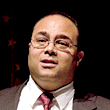Radio wars

For Nancy Jesuale, director of communications services for the city of Portland, Ore., deciding how to allocate radio frequency spectrum poses a trade-off between the needs of "soccer moms [and] burning babies."
For Nancy Jesuale, director of communications services for the city of Portland, Ore., deciding how to allocate radio frequency spectrum poses a trade-off between the needs of "soccer moms [and] burning babies." Jesuale's strong characterization exemplified the lively debates running through the National Telecommunications and Information Administration's Spectrum Summit in Washington, held in April to address the growing interest of commercial telecommunications carriers in swaths of the radio frequency spectrum now held by government agencies.The NTIA, which oversees the government's use of spectrum, called together representatives from industry and the Federal Communications Commission, which oversees the commercial use of airwave space, to gather information and help it decide whether to release any government-allotted spectrum for commercial use.Telecom representatives said they need more spectrum to open new markets and improve existing cellular phone services. Countries such as Japan, the United Kingdom and Germany have allocated more spectrum to commercial use and are jumping ahead of the United States technologically, they said. But government officials, especially those from the Defense Department and public safety agencies, contend that government spectrum should be kept intact for times of crisis, such as the Sept. 11 terrorist attacks.Complicating the issue are the potential billions of dollars the government could receive for auctioning the spectrum. Just for the 1,800 megahertz range alone, now used by the military, carriers might pay up to $45 billion in order to deploy it for their own third generation, or 3G, cellular telephone services, according to the American Enterprise Institute for Public Policy Research, a Washington think tank.That would buy a lot of new equipment for the military. Systems integrators in the federal telecom market could expect to see $5 billion to $10 billion of those auction proceeds used to upgrade government equipment to other frequencies, said Norman Ornstein, a resident scholar at the institute.An NTIA 2001 report, "Assessment of Electromagnetic Spectrum Reallocation," summarized the extensive work agencies take on when they shift radios to new frequencies. For example, they must develop new equipment when modifying existing equipment or using commercial products is not possible. Also, new equipment must be exhaustively tested and integrated into the agency's core mission systems. Calibration and maintenance equipment have to be procured, and personnel must be retrained. And all this work must adhere to high quality of service levels, especially for the Defense Department, which, in its move to network-centric warfare, is increasing its reliance on communications systems for such things from data-intensive jet fighter systems to radio-controlled unmanned combat vehicles."Replacing all the equipment all the way from the U.S. Central Command in Tampa down to radio terminals in the field would be a huge undertaking," said Adam Guy, wireless analyst for the Strategis Group, a Washington telecommunications research and consulting firm.However, the military bristles at the suggestion that it give up any of its spectrum. John Stenbit, assistant secretary of defense for command, control, communications and intelligence for the Department of Defense, said he was terrified by some of the proposals he has seen. He has voiced concern that the Treasury Department hasn't yet guaranteed the money from the spectrum auctions would cover the complete costs of radio modernization.Industry officials offered solutions for dealing with the displaced agency communications, including emergency services on an outsourced basis. John Stanton, chief executive officer for Voicestream Wireless Corp., Bellevue, Wash., said wireless networks can offer 98 percent uptime, and even better performance could be achieved through more investment. FCC chairman Michael Powell said agencies can use their requests for proposals as a way to force carriers to increase reliability. "The government is a heck of a buyer when it decides to buy," Powell said.However, Glen Nash, president for the Association of Public Safety Communications Officials, expressed doubt that commercial services could offer the same reliability and range of coverage as government-built systems. "Emergency services require complete coverage, not just in those areas densely populated," he said.Another potential solution was "dynamic allocation," in which emergency personnel could have first priority of the airwaves during times of crisis, but usage would revert back to mostly commercial traffic at other times, said Bradley Homes, senior vice president of regulatory and government affairs for wireless technology developer ArrayComm Inc., San Jose, Calif.Stenbit said his concern with dynamic allocation is that under current proposals, government would still assume responsibility for problems caused by commercial users. The radio frequency spectrum used by the Department of Defense for missile guidance testing, for example, is not heavily used but requires strict quality assurance. Should a company want to share that space, Stenbit said, the company should be held legally liable for any damage done if its faulty service caused a missile to swerve into a nearby city."Are they prepared to assume this risk?" Stenbit said.Not all agencies voiced disapproval of frequency sharing. Michael Duffy, director of telecommunications services for the Justice Department, said that as commercial telecommunications services mature, they will be increasingly used by the government, lessening the need to cordon off sections of spectrum. For example, many law enforcement officers prefer using cellular phones over aging, less-reliable government-issued land mobile radios.While no one expects an immediate change in NTIA policy governing the use of military and other public airwaves, analysts said the two-day summit brought the FCC and NTIA into closer collaboration. Jon Peha, associate director for the Center for Wireless and Broadband Networks at Carnegie Mellon University, said the meeting showed there is a lot more cooperation between the two agencies."We didn't see that flexibility before," he said."There's been some softening going on at NTIA," Guy said.


Staff Writer Joab Jackson can be reached at jjackson@postnewsweektech.com.

John Stenbit, assistant secretary of Defense, said he was terrified by some of the reallocation proposals he has seen.

FCC Chairman Michael Powell said the government has the leverage to force commercial carriers to increase reliability.
Staff Writer Joab Jackson can be reached at jjackson@postnewsweektech.com.
NEXT STORY: WHO'S ON FIRST